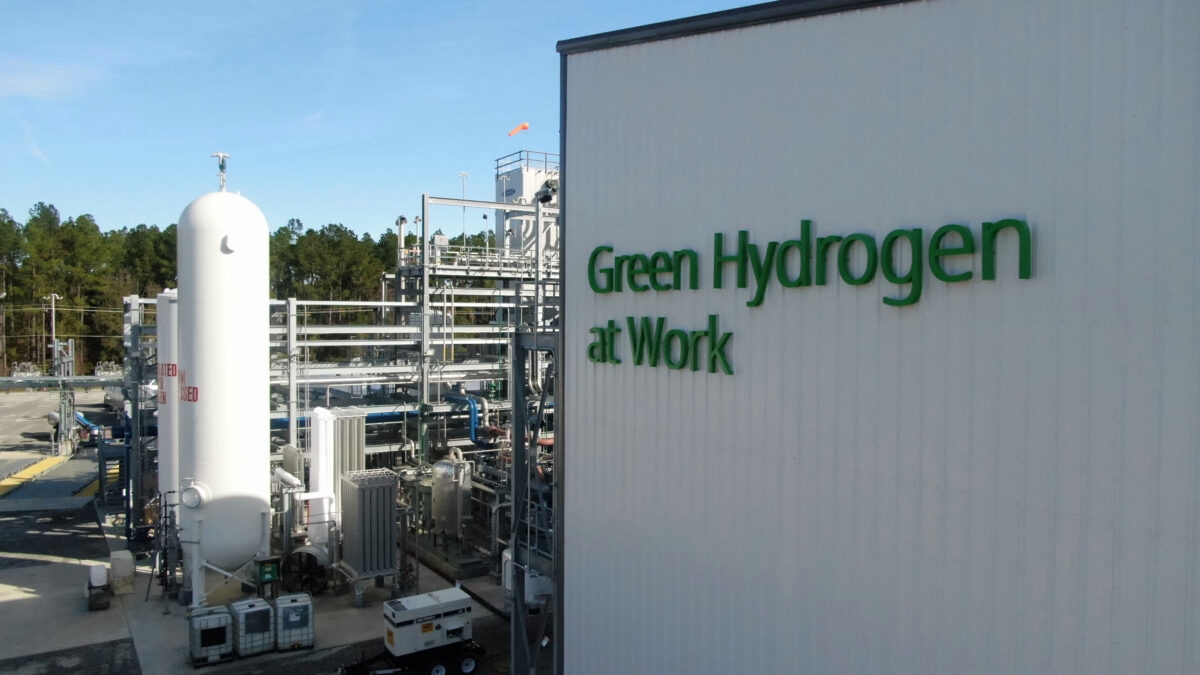The U.S. Department of Energy’s (DOE) Loan Programs Office (LPO) announced a conditional commitment to Plug Power’s subsidiary, Plug Power Energy Loan Borrower, for a loan guarantee of up to $1.66 billion to help finance the construction of up to six clean hydrogen facilities across several states.
Clean or “green” hydrogen differs from traditional “blue” hydrogen, by using renewable energy sources such as solar and wind rather than fossil fuel-based electricity.
Advancing clean hydrogen is a key component of the Biden-Harris Administration’s plan to build a robust clean energy economy. To advance clean hydrogen the administration created an inter-agency hydrogen task force to deploy a more holistic, “whole of government approach” to clean hydrogen across the administration.
Clean hydrogen has potential in industries that would otherwise be hard to decarbonize, including heavy-duty transportation. A year ago, the Biden-Harris Administration put out a National Clean Hydrogen Strategy and Roadmap, outlining opportunities for the U.S. to domestically produce 10 million metric tonnes (MMT) of clean hydrogen annually by the end of the decade, 20 MMT annually by 2040, and 50 MMT annually by 2050.
In October, the DOE announced funding of $7 billion to launch seven regional clean hydrogen hubs around the country, each aimed at more broadly supporting the commercial-scale deployment of the resource. The funding for the hubs comes from the 2021 Bipartisan Infrastructure Law. All seven hubs are estimated to produce a joint three million metric tons of hydrogen each year, and slash 25 million metric tons of carbon dioxide emissions every year.
This loan guarantee to Plug, if finalized, will support an estimated 100 to 300 jobs during the construction period when at full capacity, and at least 50 new full-time jobs for each location.
Plug has a development pipeline that includes the build-out of clean hydrogen facilities in several potential locations across the United States to supply its national customer base with end-to-end clean hydrogen at scale.
Plug’s hydrogen generation network reached significant milestones early in 2024. Its plants in Georgia and Tennessee produced at nameplate capacity, with a combined liquid hydrogen production capacity of 25 tons-per-day (TPD). Additionally, Plug’s Louisiana plant is expected to be completed and begin producing this year, adding 15 TPD and bringing the Company’s total liquid hydrogen production capacity to 40 TPD. If finalized, the loan funding will support an integrated and resilient commercial scale clean hydrogen fueling network across several regions of the United States.
The clean hydrogen facilities will use Plug’s own electrolyzer stacks that are manufactured at the company’s state-of-the-art gigafactory in Rochester, N.Y. Plug is among the leading commercial-scale manufacturers of electrolyzers in the United States and currently operates the largest Proton Exchange Membrane (PEM) electrolyzer system in the United States at its Georgia hydrogen plant.
Electrolyzers use electricity to split water into its component parts, hydrogen and oxygen. Plug’s PEM technology reportedly allows it to operate efficiently even with variable electricity, enabling it to leverage electricity from intermittent renewables. Electrolyzers that use renewables to power their hydrogen production produce emissions-free clean hydrogen. The electrolyzer stacks can be easily configured to produce systems at 1 MW, 5 MW and 10 MW scales.
The hydrogen fuel from the project is expected to power fuel cell-electric vehicles used in the material handling, transportation, and industrial sectors, resulting in an estimated 84% reduction in greenhouse gas emissions compared to conventional blue hydrogen production.
The benefits of harnessing hydrogen fuel cells in applications such as material handling equipment include enhanced operational efficiency, reduced environmental impact through zero-emission operations, and increased productivity due to faster refueling times compared to conventional batteries. Major corporations such as Amazon, Walmart, and Home Depot use Plug’s hydrogen fuel cells across their warehouse and distribution centers.
Plug is expected to develop and ultimately implement a strong Community Benefits Plan for each project and has committed to working with local communities for project siting, including soliciting input from local economic development corporations.
LPO works with all borrowers to create good-paying jobs with strong labor standards from construction through the life of the loan. Plug also supports the Justice40 Initiative, which set the goal that 40% of overall benefits of certain federal investments flow to disadvantaged communities overburdened by pollution.
While this conditional commitment indicates DOE’s intent to finance the project, the company must satisfy certain technical, legal, environmental, and financial conditions before the Department enters into definitive financing documents and funds the loan guarantee.
This content is protected by copyright and may not be reused. If you want to cooperate with us and would like to reuse some of our content, please contact: editors@pv-magazine.com.









By submitting this form you agree to pv magazine using your data for the purposes of publishing your comment.
Your personal data will only be disclosed or otherwise transmitted to third parties for the purposes of spam filtering or if this is necessary for technical maintenance of the website. Any other transfer to third parties will not take place unless this is justified on the basis of applicable data protection regulations or if pv magazine is legally obliged to do so.
You may revoke this consent at any time with effect for the future, in which case your personal data will be deleted immediately. Otherwise, your data will be deleted if pv magazine has processed your request or the purpose of data storage is fulfilled.
Further information on data privacy can be found in our Data Protection Policy.